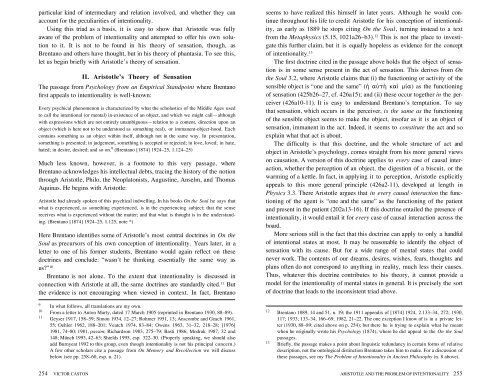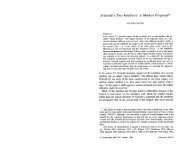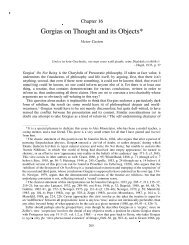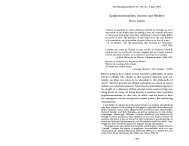Aristotle and the Problem of Intentionality. - Ancient Philosophy ...
Aristotle and the Problem of Intentionality. - Ancient Philosophy ...
Aristotle and the Problem of Intentionality. - Ancient Philosophy ...
You also want an ePaper? Increase the reach of your titles
YUMPU automatically turns print PDFs into web optimized ePapers that Google loves.
particular kind <strong>of</strong> intermediary <strong>and</strong> relation involved, <strong>and</strong> whe<strong>the</strong>r <strong>the</strong>y canaccount for <strong>the</strong> peculiarities <strong>of</strong> intentionality.Using this triad as a basis, it is easy to show that <strong>Aristotle</strong> was fullyaware <strong>of</strong> <strong>the</strong> problem <strong>of</strong> intentionality <strong>and</strong> attempted to <strong>of</strong>fer his own solutionto it. It is not to be found in his <strong>the</strong>ory <strong>of</strong> sensation, though, asBrentano <strong>and</strong> o<strong>the</strong>rs have thought, but in his <strong>the</strong>ory <strong>of</strong> phantasia. To see this,let us begin briefly with <strong>Aristotle</strong>’s <strong>the</strong>ory <strong>of</strong> sensation.II. <strong>Aristotle</strong>’s Theory <strong>of</strong> SensationThe passage from Psychology from an Empirical St<strong>and</strong>point where Brentan<strong>of</strong>irst appeals to intentionality is well-known:Every psychical phenomenon is characterized by what <strong>the</strong> scholastics <strong>of</strong> <strong>the</strong> Middle Ages usedto call <strong>the</strong> intentional (or mental) in-existence <strong>of</strong> an object, <strong>and</strong> which we might call—althoughwith expressions which are not entirely unambiguous—relation to a content, direction upon anobject (which is here not to be understood as something real), or immanent-object-hood. Eachcontains something as an object within itself, although not in <strong>the</strong> same way. In presentation,something is presented; in judgement, something is accepted or rejected; in love, loved; in hate,hated; in desire, desired; <strong>and</strong> so on. 9 (Brentano [1874] 1924–25, 1.124–25)Much less known, however, is a footnote to this very passage, whereBrentano acknowledges his intellectual debts, tracing <strong>the</strong> history <strong>of</strong> <strong>the</strong> notionthrough <strong>Aristotle</strong>, Philo, <strong>the</strong> Neoplatonists, Augustine, Anselm, <strong>and</strong> ThomasAquinas. He begins with <strong>Aristotle</strong>:<strong>Aristotle</strong> had already spoken <strong>of</strong> this psychical indwelling. In his books On <strong>the</strong> Soul he says thatwhat is experienced, as something experienced, is in <strong>the</strong> experiencing subject; that <strong>the</strong> sensereceives what is experienced without <strong>the</strong> matter; <strong>and</strong> that what is thought is in <strong>the</strong> underst<strong>and</strong>ing.(Brentano [1874] 1924–25, 1.125, note *)Here Brentano identifies some <strong>of</strong> <strong>Aristotle</strong>’s most central doctrines in On <strong>the</strong>Soul as precursors <strong>of</strong> his own conception <strong>of</strong> intentionality. Years later, in aletter to one <strong>of</strong> his former students, Brentano would again reflect on <strong>the</strong>sedoctrines <strong>and</strong> conclude: “wasn’t he thinking essentially <strong>the</strong> same way asus?” 10Brentano is not alone. To <strong>the</strong> extent that intentionality is discussed inconnection with <strong>Aristotle</strong> at all, <strong>the</strong> same doctrines are st<strong>and</strong>ardly cited. 11 But<strong>the</strong> evidence is not encouraging when viewed in context. In fact, Brentano9 In what follows, all translations are my own.10 From a letter to Anton Marty, dated 17 March 1905 (reprinted in Brentano 1930, 88–89).11 Geyser 1917, 158–59; Simon 1934, 12–27; Rohmer 1951, 13; Anscombe <strong>and</strong> Geach 1961,55; Oehler 1962, 188–201; Veatch 1974, 83–84; Owens 1963, 31–32, 218–28; [1976]1981, 74–80; 1981, passim; Richardson 1983, 275–79; Basti 1986; Modrak 1987, 32 <strong>and</strong>148; Münch 1993, 42–63; Shields 1995, esp. 322–30. (Properly speaking, we should alsoadd Burnyeat 1992 to this group, even though intentionality is not his principal concern.)A few o<strong>the</strong>r scholars cite a passage from On Memory <strong>and</strong> Recollection we will discussbelow (see pp. 258–60, esp. n. 21).seems to have realized this himself in later years. Although he would continuethroughout his life to credit <strong>Aristotle</strong> for his conception <strong>of</strong> intentionality,as early as 1889 he stops citing On <strong>the</strong> Soul, turning instead to a textfrom <strong>the</strong> Metaphysics (5.15, 1021a26–b3). 12 This is not <strong>the</strong> place to investigatethis fur<strong>the</strong>r claim, but it is equally hopeless as evidence for <strong>the</strong> concept<strong>of</strong> intentionality. 13The first doctrine cited in <strong>the</strong> passage above holds that <strong>the</strong> object <strong>of</strong> sensationis in some sense present in <strong>the</strong> act <strong>of</strong> sensation. This derives from On<strong>the</strong> Soul 3.2, where <strong>Aristotle</strong> claims that (i) <strong>the</strong> functioning or activity <strong>of</strong> <strong>the</strong>sensible object is “one <strong>and</strong> <strong>the</strong> same” (≤ aÈtØ ka‹ m¤a) as <strong>the</strong> functioning<strong>of</strong> sensation (425b26–27, cf. 426a15); <strong>and</strong> (ii) <strong>the</strong>se occur toge<strong>the</strong>r in <strong>the</strong> perceiver(426a10-11). It is easy to underst<strong>and</strong> Brentano’s temptation. To saythat sensation, which occurs in <strong>the</strong> perceiver, is <strong>the</strong> same as <strong>the</strong> functioning<strong>of</strong> <strong>the</strong> sensible object seems to make <strong>the</strong> object, ins<strong>of</strong>ar as it is an object <strong>of</strong>sensation, immanent in <strong>the</strong> act. Indeed, it seems to constitute <strong>the</strong> act <strong>and</strong> soexplain what that act is about.The difficulty is that this doctrine, <strong>and</strong> <strong>the</strong> whole structure <strong>of</strong> act <strong>and</strong>object in <strong>Aristotle</strong>’s psychology, comes straight from his more general viewson causation. A version <strong>of</strong> this doctrine applies to every case <strong>of</strong> causal interaction,whe<strong>the</strong>r <strong>the</strong> perception <strong>of</strong> an object, <strong>the</strong> digestion <strong>of</strong> a biscuit, or <strong>the</strong>warming <strong>of</strong> a kettle. In fact, in applying it to perception, <strong>Aristotle</strong> explicitlyappeals to this more general principle (426a2-11), developed at length inPhysics 3.3. There <strong>Aristotle</strong> argues that in every causal interaction <strong>the</strong> functioning<strong>of</strong> <strong>the</strong> agent is “one <strong>and</strong> <strong>the</strong> same” as <strong>the</strong> functioning <strong>of</strong> <strong>the</strong> patient<strong>and</strong> present in <strong>the</strong> patient (202a13-16). If this doctrine entailed <strong>the</strong> presence <strong>of</strong>intentionality, it would entail it for every case <strong>of</strong> causal interaction across <strong>the</strong>board.More serious still is <strong>the</strong> fact that this doctrine can apply to only a h<strong>and</strong>ful<strong>of</strong> intentional states at most. It may be reasonable to identify <strong>the</strong> object <strong>of</strong>sensation with its cause. But for a wide range <strong>of</strong> mental states that couldnever work. The contents <strong>of</strong> our dreams, desires, wishes, fears, thoughts <strong>and</strong>plans <strong>of</strong>ten do not correspond to anything in reality, much less <strong>the</strong>ir causes.Thus, whatever this doctrine contributes to his <strong>the</strong>ory, it cannot provide amodel for <strong>the</strong> intentionality <strong>of</strong> mental states in general. It is precisely <strong>the</strong> sort<strong>of</strong> doctrine that leads to <strong>the</strong> inconsistent triad above.12 Brentano 1889, 14 <strong>and</strong> 51, n. 19; <strong>the</strong> 1911 appendix <strong>of</strong> [1874] 1924, 2.133–34, 272; 1930,117; 1933, 133–34, 166–69; 1982, 21–22. The one exception I know <strong>of</strong> is in a private letter(1930, 88–89; cited above on p. 254); but <strong>the</strong>re he is trying to explain what he meantwhen he originally wrote his Psychology (1874), where he did appeal to <strong>the</strong> On <strong>the</strong> Soulpassages.13 Briefly, <strong>the</strong> passage makes a point about linguistic redundancy in certain forms <strong>of</strong> relativedescription, not <strong>the</strong> ontological distinction Brentano takes him to make. For a discussion <strong>of</strong><strong>the</strong>se passages, see my The <strong>Problem</strong> <strong>of</strong> <strong>Intentionality</strong> in <strong>Ancient</strong> <strong>Philosophy</strong> (n. 8 above).254 VICTOR CASTONARISTOTLE AND THE PROBLEM OF INTENTIONALITY 255





